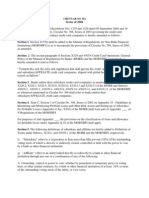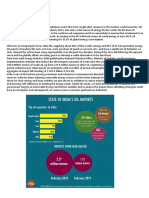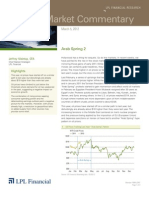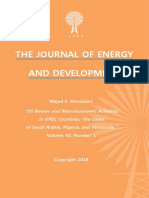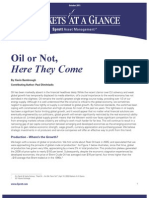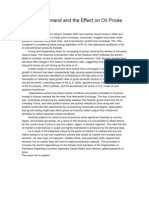Oil Price Shocks and The Nigeria Economy: A Variance Autoregressive (VAR) Model
Oil Price Shocks and The Nigeria Economy: A Variance Autoregressive (VAR) Model
Uploaded by
Diamante GomezCopyright:
Available Formats
Oil Price Shocks and The Nigeria Economy: A Variance Autoregressive (VAR) Model
Oil Price Shocks and The Nigeria Economy: A Variance Autoregressive (VAR) Model
Uploaded by
Diamante GomezOriginal Description:
Original Title
Copyright
Available Formats
Share this document
Did you find this document useful?
Is this content inappropriate?
Copyright:
Available Formats
Oil Price Shocks and The Nigeria Economy: A Variance Autoregressive (VAR) Model
Oil Price Shocks and The Nigeria Economy: A Variance Autoregressive (VAR) Model
Uploaded by
Diamante GomezCopyright:
Available Formats
www.ccsenet.
org/ijbm
International Journal of Business and Management
Vol. 5, No. 8; August 2010
Oil Price Shocks and the Nigeria Economy:
A Variance Autoregressive (VAR) Model
GUNU UMAR (Ph. D)
Department of Business Administration, University of Ilorin, Ilorin, Nigeria
Tel: 234-805-5912-617
E-mail: gunu_umar_2002@yahoo.com
KILISHI, A. ABDULHAKEEM
Department of Economics, University of Ilorin, Ilorin, Nigeria
Tel: 234-805-0221-980
E-mail: meetkilishi@yahoo.com
Abstract
Oil prices have been highly volatile since the end of World War II. The volatility becomes even more serious in
recent time. This has implications for the economies of oil exporting countries, particularly oil dependent
countries like Nigeria. The paper examined the impact of these fluctuations on macroeconomic of Nigeria.
Using VAR, the impact of crude oil price changes on four key macroeconomic variables was examined. The
results show that oil prices have significant impact on real GDP, money supply and unemployment. It impact on
the fourth variable, consumer price index is not significant. This implies that three key macroeconomic variables
in Nigeria are significantly explained by exogenous and the highly volatile variable. Hence, the economy is
vulnerable to external shocks. Consequently, the macroeconomic performance will be volatile and
macroeconomic management will become difficult. Diversification of the economy is necessary in order to
minimize the consequences of external shocks.
Keywords: Oil prices, Vector autoregressive, Macroeconomic variables, Diversification
1. Introduction
Since oil was discover in commercial quantity in Nigeria, oil has dominated the economy of the country. In
Nigeria, oil accounts for more than 90 percent of its exports, 25 percent of its Gross Domestic Product (GDP),
and 80 percent of its government total revenues. Thus, a small oil price changes can have a large impact on the
economy. For instance a US$1 increase in the oil price in the early 1990s increased Nigeria's foreign exchange
earnings by about US$650 million (2 percent of GDP) and its public revenues by US$320 million a year.
Nigeria's reliance on oil production for income generation clearly has serious implications for its economy.
Secondly, oil is an important commodity in the economy of any country in the world because it is a major source
of energy for domestic and industrial use. Oil therefore serves as intermediate product and as well as consumer
commodity. There are different end products of oil; these include kerosene, diesel, gasoline, and others. Changes
in the prices of either the crude oil or any of the end products are expected to have impact on users and the nation
at large.
Oil prices traditionally have been more volatile than many other commodity or asset prices since World War II.
The trend of demand and supply in the global economy coupled with activities of OPEC consistently affects the
price of oil. The recent changes in oil prices in the global economy are so rapid and unprecedented. This is partly
due to increased demand of oil by China and India. However, the current global economy melt down suddenly
counteracted the skyrocketing oil price. At the beginning of the crisis oil price crashed below $40/b in the world
market which had serious consequences on Nigeria fiscal budget which led to the downward review of the
budget oil bench mark price. Today oil price is oscillating between $60/b and $75/b. This rapid change has
become a great concern to everybody including academics and policy makers; therefore a study of this kind is
timely.
The objective of this paper is to examine the impact of oil price fluctuation in the Nigeria economy using some
key macroeconomic variables. A vector auto regression (VAR) model is developed and variance decomposition
test is carried out. The paper is divided in to six sections, following this introduction is section two which
presents the trend of oil prices. Section three focuses on empirical evidences of the relationship between oil price
Published by Canadian Center of Science and Education
39
www.ccsenet.org/ijbm
International Journal of Business and Management
Vol. 5, No. 8; August 2010
and economic performance. Section four is the methodology and analysis of VAR, while section five presented
the results and discussed the variance decomposition and section six concludes the paper.
2. Trend of Oil Prices
Crude prices have been very volatile since 1999. Spikes from March 1999 are because of the following factors: (i)
OPEC restricted crude oil production and there is greater cooperation among its members; (ii) Asian growing oil
demand signifying recovery from crisis; and (iii) shrinking non-OPEC production. The world market responded
accordingly with sharp increase in prices, with crude oil prices increasing and exceeding US$30/b towards the
end of 2000. OPEC then tried to maintain prices at a range between US$22/b and US$28/b by increasing or
reducing production, and with increases in output by non-OPEC producers, particularly Russia. The September
11 2001 incident sent crude oil prices plummeting, despite earlier production increases by non-OPEC producers
and reduction of quotas by OPEC member countries. Soon afterwards, prices moved to the US$25/b range. In
2004, prices moved above this range, with the Brent crude hovering above US$40/b per barrel during the year.
Factors contributing to the increase can be isolated as follows: the continued fall in the US dollar and following
political tension in the Middle East, the high demand for crude oil by China and uncertainty about the future of
Yukos, the Russian oil producer. The falling of the US dollar against other major currencies contributed to
increasing fuel prices.
The banking crisis that erupted in September 2008, following more than a year of less acute financial turmoil,
has substantially reinforced the cyclical downturn that was already under way. Following the insolvency of a
large number of banks and financial institutions in the United States, Europe, and the developing world, financial
conditions have become much tighter. The consequent global economic meltdown resulted to crash in oil prices.
Figure 1 shows the trend of oil price from 1970 to 2009 (see appendix 1).
To capture the volatility of oil price it is important to consider recent fluctuations in the market, thus figure two
shows the monthly oil prices of three years, 2007, 2008 and 2009 as shown in appendix 1.
Both figures one and two show the volatility of oil prices. At the beginning of 2008 the net price of oil was less
US$100/b, mid of the year it was above US$140/b and by the end it stood below US$40/b. The changes were
almost weekly, this is obvious from figure 2. The presence of high volatility commonly associated with claims that
markets often overshoot relative to underlying fundamentals. It would appear obvious to most observers that the
price swings of the past year represent prime examples of overshooting. However, this conclusion may not be as
valid as it may appear at first glance. After all, changes in underlying economic fundamentals themselves can lead
to complicated price dynamics.
Sometimes the changes in the crude oil prices does not translate to changes in domestic end user prices of oil
products, because of the dynamics of domestic demand and supply, domestic policies such as subsidy and price
regulations. Hence, fluctuations in crude oil prices may not have much impact in the domestic economy through
the domestic end user prices. Therefore, it might be interesting to examine the price movement of end user prices
of kerosene, gasoline (known as petroleum in Nigeria) and diesel.
Monthly average world gasoline prices increased from US$0.26 a liter in January 2004 to US$0.37 in January
2007 and to US$0.73 by August 2008. Diesel prices were US$0.25 a liter in January 2004, US$0.42 in January
2007, and US$0.84 in August 2008. During this period, some developing countries experienced a large currency
appreciation which partially helped offset oil price increases. Other countries experienced currency depreciation,
exacerbating the impact of steep oil price rises.
Retail fuel prices of gasoline and diesel in August 2008 were, on average, about 50 percent higher in
industrialised countries than in developing countries. Gasoline, diesel, and household kerosene prices in
oil-importing developing countries were twice as high as those in oil-exporting countries. By region,
Sub-Saharan Africa had the highest gasoline and diesel prices in the developing world, a consequence of the
landlocked nature of some of its countries, inadequate economies of scale in small markets, inadequate
infrastructure for transporting fuels, rising demand for diesel to offset power shortages, and relatively high rates
of taxation. Retail prices in Asia and Latin America were comparable. Retail prices of liquefied petroleum gas,
used in household cooking, were low in relation to world prices, reflecting the tendency of governments to
subsidize this fuel. However, a number of countriesincluding Bangladesh, China, Egypt, Ethiopia, India,
Indonesia, the Islamic Republic of Iran, Malaysia, Nepal, Nigeria, Sri Lanka, the Syrian Arab Republic,
Venezuela, and the Republic of Yemenset fuel prices in an ad hoc manner, and most have seen growing price
subsidies in recent years.
40
ISSN 1833-3850
E-ISSN 1833-8119
www.ccsenet.org/ijbm
International Journal of Business and Management
Vol. 5, No. 8; August 2010
In Nigeria the domestic retail prices are regulated and subsidize by government, however, the prices are adjusted
(upward or downward) from time to time. Figure three shows retail prices of major petroleum products as shown
in appendix 1.
3. Oil Price and the Economy: Empirical Evidence
The oil price shock of 1973 and the subsequent recession gave rise to a plethora of studies analyzing the effects
of oil price increases on the economy. The early studies included Pierce and Enzler (1974), Rasche and Tatom
(1977), Mork and Hall (1980), and Darby (1982), all of which documented and explained the inverse
relationship between oil price increases and aggregate economic activity. Later empirical studiessuch as,
Gisser and Goodwin (1986) and the study on Energy Modeling Forum as documented in Hickman et al.
(1987)confirmed the inverse relationship between oil prices and aggregate economic activity. Darby (1982),
Burbidge and Harrison (1984), and Bruno and Sachs (1982, 1985) documented similar oil-price-economy
relationships in cross country analysis. Hamilton (1983) made a definitive contribution by extending the analysis
to show that all but one of the post-World-War-II recessions were preceded by rising oil prices and those other
business cycle variables could not account for the recessions. This is also evident in the current economic
meltdown.
In an extensive survey of the empirical literature, Jones and Leiby (1996) found that the estimated oil price
elasticity of GNP in the early studies ranged from -0.02 to -0.08, with the estimates consistently clustered around
-0.05. Tobin (1980) thought the estimated effects seemed too high to be consistent with a classic supply shock,
but Jones and Leiby (1996) argued that values around -0.05 are in the ballpark for output elasticities that are
roughly equal to factor shares. After the 1973 oil-price shock, oils share in GNP was around 4-6 percent.
Several different channels have been proposed to account for the inverse relationship between oil price
movements and aggregate economic activity. The most basic is the classic supply-side effect in which rising oil
prices are indicative of the reduced availability of a basic input to production. Other explanations include income
transfers from the oil-importing nations to the oil-exporting nations, a real balance effect and monetary policy.
Of these explanations, the classic supply-side effect best explains why rising oil prices slows GDP growth and
stimulates inflation.
Rising oil prices can be indicative of a classic supply-side shock that reduces potential output, as in Rasche and
Tatom (1977 and 1981), Barro (1984) and Brown and Ycel (1999). Rising oil prices signal the increased
scarcity of energy which is a basic input to production. Consequently, the growth of output and productivity are
slowed. The decline in productivity growth lessens real wage growth and increases the unemployment rate at
which inflation accelerates. If consumers expect the rise in oil prices to be temporary, or if they expect the near
term effects on output to be greater than the long-term effects, they will attempt to smooth out their consumption
by saving less or borrowing more which boosts the equilibrium real interest rate. With slowing output growth
and an increase in the real interest rate, the demand for real cash balances falls, and for a given rate of growth in
the monetary aggregate, the rate of inflation increases. Therefore, rising oil prices reduce GDP growth and boost
real interest rates and the measured rate of inflation.
If wages are nominally sticky downward, the reduction in GDP growth will lead to increased unemployment and
a further reduction in GDP growthunless unexpected inflation increases as much as GDP growth falls. The
initial reduction in GDP growth is accompanied by a reduction in labor productivity. Unless real wages fall by as
much as the reduction in labor productivity, firms will lay off workers, which will generate increased
unemployment and further GDP losses. If wages are nominally sticky downward, the only mechanism through
which the necessary wage reduction can occur is through unexpected inflation that is at least as great as the
reduction in GDP growth.
However, studies in Nigeria such as Olusegun (2008), Christopher and Benedikt (2006) and Philip and Akintoye
(2006) did not find any significant impact of oil price shock on variables like: money supply, price level, and
output and government expenditure.
4. Methodology and Model Specification
4.1 Features of VAR
The paper makes use of Variance Autoregressive (VAR) Model. Generally a VAR model is specified as:
yt = m + A1yt-1 + A2yt-2 + + Apy1-p + t ----------------------(1)
Equation (1) specifies VAR (P) process, where Ai (i= 1,2,,p) are K x K matrices of coefficients, m is a K x 1
vector of constants and t is a vector of white noise process.
Published by Canadian Center of Science and Education
41
www.ccsenet.org/ijbm
International Journal of Business and Management
Vol. 5, No. 8; August 2010
The easiest way to appreciate the feature of VAR is to specify a simple VAR. Consider a simple VAR where K=
2 and p=1. This gives:
yt= m + Ayt-1 + t
+
..(2)
more explicitly, this can be written as:
y1t = m1 + a11y1,t-1 + a12y2,t-1+ 1t
y2t = m2 + a21y1,t-1 + a22y2,t-1 + 2t
Thus, each variable in VAR is expressed as a linear combination of lagged values of itself and lagged values of
all other variables in the group. The behavior of the y depend on the properties of the A matrix. If the Eigen
values and Eigen vectors of the A matrix are:
C=
Provided the Eigen values are distinct, the eigenvectors will be linearly independent and C will be nonsingular. It
then follows that
AC=
and A= C
----------------- (3)
Defining a new vector Zt as:
Zt =
The process of pre-multiplying (2) by
yt or yt = CZt -----------------(4)
and simplifying gives:
Zt = m* +
Where m* =
Thus:
m and
t =
Z1t = m*1 +
Z2t = m*2 +
Zt-1 + t -------------------------(5)
Z1,t-1 + 1t
Z2,t-1 + 2t
Each Z variable follows a separate AR(1) process and is stationary I(0), if the Eigen value has modulus less than
1; is a random walk with drift I(1), if the Eigen value is 1; and is explosive, if the eigen value exceeds 1 in
numerical value. Finally, it is important to look for the cointegrating relation. Using equation (4) such relation
can readily be found. The second bottom row in equation (4) gives:
Z2t = c (2)yt -------------------------(6)
Where c(2) is the bottom row in C-1. Thus, z2 is the linear combination of I(1)variables but is itself a stationary I(0)
variable. The cointegrating vector annihilates the I(1) component in yt.
a. Model Specification
The model for this study is specified as:
42
ISSN 1833-3850
E-ISSN 1833-8119
www.ccsenet.org/ijbm
International Journal of Business and Management
Vol. 5, No. 8; August 2010
Where:
GPD is Real Gross Domestic Product; UNE is unemployment; CPI is Consumer Price Index; M1 is money supply
and COP is crude oil prices. M1 is included to represent the financial sector. L is the lag length; t is time and is
vector of innovations. The variables are time series variables and the data is sourced from CBN bulletin and OPEC
bulletin respectively.
The VAR model is adopted for this study because of the forecasting power relative to large structural models.
Again one of the common virtue of VAR is that it obviates a decision as to what contemporaneous variables are
exogenous, all variables are endogenous.
5. Results and Discussion
The estimation and analysis of the model involves multi-stage procedure. The study first considered the
correlogram for crude oil prices (COP). As shown in figure 4, in appendix 1, COP displays the classical pattern for
AR (1) series, with the autocorrelations dying out and only the first partial correlation coefficient being significant.
As with most macroeconomic variables, all the five variables of the model are nonstationary at levels. Both
Augmented Dickey- Fuller (ADF) and Phillips Perron unit root tests are conducted. The two tests show similar
results, except for M1 which is not stationary at 5% even at the second difference. However, Phillips- Perron test
shows that COP, GDP and UNE are stationary at I(1), while CPI and M1 are stationary at I(2). Tables 1 and 2
showed results of the tests as indicated in appendix 1.
As a matter of necessity, the study tested for cointegration using the Johansen approach which is suitable for VAR
model. The result shows that (at 5%) there is at least one cointegrating relation in each of the models (see figure 5
in appendix 1). This naturally allowed us to proceed to the estimation of VAR. Meanwhile, before estimating VAR,
Pairwise Granger Causality tests were conducted. The results are presented in table 3 (see appendix 1). At 5%
significance level there are evidences that CPI granger caused COP, M1 granger caused COP, CPI granger caused
M1, UNE granger caused GDP and M1 granger caused UNE. Other granger causalities are not statistically
significant.
The results of the VAR estimates are shown in table 4 in appendix 1. The result of GDP equation showed
significant positive relationship between GDP and first and second lag of COP, and first lag of CPI. There is also
significant but negative relation between GDP and second lag of CPI. The entire remaining variables have
insignificant coefficients. The coefficients of the error correction terms in the GDP equation are significant but
positive. The R2 shows the model of this equation explains about 63% variations in GDP. In CPI equation the
coefficients of first and second lag of GDP, M1 and UNE are significant and positive. Coefficients of lags of
COP and CPI are not significant. However, first lag of COP is positive and the second lag is negative. In M1
Published by Canadian Center of Science and Education
43
www.ccsenet.org/ijbm
International Journal of Business and Management
Vol. 5, No. 8; August 2010
equation, the coefficient of the lags of COP, and CPI are significant, while all others are not. The first lag of
COP has positive coefficient while the second lag has negative coefficient. In UNE equation only the
coefficients of lags of COP and CPI are significant while others are not. Both the first and second lags of COP
are negative to UNE. M1 equation has the highest R2 with about 92%, while UNE equation has the lowest with
about 27%.
Discussion of Results
The GDP in Nigeria increases as crude oil prices rise, this is evident from the result of the study. The implication
is that the economic growth of the country is driven by external forces, since crude oil prices are determine by
exogenous factors. This means that, if crude oil prices decline the GDP of the country will equally fall. This may
result to Dutch disease. The impulse response function presented in the Appendix 2 confirms this argument.
Impulse functions show that COP and GDP exhibited volatile response to innovations. CPI and UNE responses
to innovations indicate gradual increase over time. Though, UNE shows little volatility. The results also show
that money supply in Nigeria is inversely related to crude oil prices. As crude oil prices increases money supply
falls, and if crude oil prices falls, money supply increases. Another important relationship shown in the result is
inverse relationship between unemployment and crude oil prices. As crude oil prices rise, unemployment reduces
in the country. The insignificant relation between crude oil prices and CPI implies that crude oil prices have no
significant influence on consumer price index in Nigeria. This is not surprising because the computation of CPI
in Nigeria does not include crude oil prices.
6. Concluding Remarks
The study concluded from the findings that crude oil prices have significant influence on three key
macroeconomic variables in Nigeria- GDP; money supply and unemployment. This constitutes serious
implication for macroeconomic management of the country because; money supply is a major macroeconomic
policy instrument, while GDP and unemployment are key macroeconomic policy targets. If these key
macroeconomic variables are influenced by a volatile, almost unpredictable exogenous variable like crude oil
prices, then the economy becomes highly vulnerable to unpredictable external shocks. The way to minimize this
is to diversify the economy so as to make it less oil dependent.
References
Barro, R. J. (1984). Macroeconomics, New York: John Wiley & Sons
Brown, S. P. A., and Ycel, M. K. (1999). Oil Prices and U.S. Aggregate Economic Activity: A Question of
Neutrality. Economic and Financial Review, Federal Reserve Bank of Dallas, Second Quarter: 16-23.
Bruno, M. R., and Sachs, J. (1981). Supply versus Demand Approaches to the Problem of Stagflation.
Macroeconomic Policies for Growth and Stability.
Burbidge, J., and Harrison, A. (1984). Testing for the Effects of Oil-Price Rises Using Vector Autoregression.
International Economic Review, 25: 459-484.
Central Bank of Nigeria Bulletin 2008
Christopher, A., and Benedikt, G. (2006). Monetary Policy and Oil Price Surges in Nigeria. Paper Presented at
Centre for the Study of African Economies, Oxford University
Darby, M.R. (1982). The Price of Oil and World Inflation and Recession. American Economic Review, 72:
738-751.
Giersch, T., and Mohr, J. C. B. (1985) Economics of Worldwide Stagflation. Cambridge, Mass: Harvard
University Press.
Gisser, M., and Goodwin, T. H. (1986). Crude Oil and the Macroeconomy: Tests of Some Popular Notions.
Journal of Money, Credit and Banking, 18: 95-103.
Hamilton, J. D. (1983). Oil and the Macroeconomy since World War II. Journal of Political Economy, 91:
28-248.
Hickman, et al, eds. (1987). Macroeconomic Impacts of Energy Shocks. Amsterdam: North- Holland.
Mork, K. A., and Hall, R. E. (1980). Energy Prices, Inflation, and Recession, 1974-1975. The Energy Journal,
1(3): 31-63.
Olusegun, O. A. (2008). Oil Price Shocks and the Nigeria Economy: A Forecast Error Variance Decomposition
Analysis. Journal of Economic Theory, 2(4) 124-130
44
ISSN 1833-3850
E-ISSN 1833-8119
www.ccsenet.org/ijbm
International Journal of Business and Management
Vol. 5, No. 8; August 2010
Organization of Petroleum Exporting Countries (OPEC) Bulletin 2009
Philip, A. O., and Akintoye, V. A. (2006). Oil Price Shock and Macroeconomic Activities in Nigeria.
International Research Journal of Finance and Economics, Issue 3
Rasche, R.H., and Tatom, J.A. (1977). The Effects of the New Energy Regime on Economic Capacity,
Production and Prices. Economic Review, 59(4): 2-12.
Tobin, J. (1980). Stabilization Policy Ten Years After. Brookings Papers on Economic Activity, 1: 19-71
Appendix 1
Table 1. Augmented Dickey Fuller Unit Root Test
Variable
ADF Statistics
Critical Value (5%)
COP
-4.17324
-2.94343
CPI
-5,87616
-2.95402
GDP
-5.99807
-2.94343
M1
2.81673
-2.63875*
UNE
-6.48980
-2.94342
Source: computed by the authors (* significant at 10%)
Oder of Integration
I(1)
I(2)
I(1)
I(2)
I(1)
Table 2. Phillips Perron Unit Root Test
Variable
Phillips-Perron Stat.
COP
-4.34184
CPI
-785286
GDP
-5.99921
M1
-4.19616
UNE
-6.48980
Source: computed by authors
Critical Value (5%)
-2.94343
-2.94584
-2.94343
-2.94584
-2.94343
Oder of Integration
I(1)
I(2)
I(1)
I(2)
I(1)
Table 3. Pairwise Granger Causality Tests
Sample: 1970 2008
Lags: 2
Null Hypothesis:
Obs
F-Statistic
Probability
CPI does not Granger Cause COP
COP does not Granger Cause CPI
37
6.35773
0.06326
0.00473
0.93882
GDP does not Granger Cause COP
COP does not Granger Cause GDP
37
1.00187
2.69075
0.37842
0.08316
M1 does not Granger Cause COP
COP does not Granger Cause M1
37
10.2495
0.12098
0.00036
0.88645
UNE does not Granger Cause COP
COP does not Granger Cause UNE
37
8.12785
0.18924
0.00140
0.82851
GDP does not Granger Cause CPI
CPI does not Granger Cause GDP
37
1.17294
1.69039
0.32241
0.20050
M1 does not Granger Cause CPI
CPI does not Granger Cause M1
37
1.01676
11.3590
0.37316
0.00019
UNE does not Granger Cause CPI
CPI does not Granger Cause UNE
37
0.11812
5.65061
0.88898
0.00791
M1 does not Granger Cause GDP
GDP does not Granger Cause M1
37
1.15381
1.61174
0.32821
0.21532
UNE does not Granger Cause GDP
GDP does not Granger Cause UNE
37
6.89783
2.39115
0.00323
0.10769
UNE does not Granger Cause M1
M1 does not Granger Cause UNE
37
0.35227
7.00399
0.70578
0.00300
Published by Canadian Center of Science and Education
45
www.ccsenet.org/ijbm
International Journal of Business and Management
Vol. 5, No. 8; August 2010
Table 4. VAR Results
46
Error Correction:
D(COP)
D(CPI)
D(GDP)
D(M1)
D(UNE)
CointEq1
-0.170788
(0.06227)
[-2.74273]
0.031095
(0.03638)
[ 0.85471]
32.06896
(215.378)
[ 0.14890]
-3109.517
(894.223)
[-3.47734]
43.71220
(587.524)
[ 0.07440]
D(COP(-1))
0.060987
(0.22633)
[ 0.26946]
0.051986
(0.13223)
[ 0.39314]
1500.944
(782.837)
[ 1.91731]
485.6375
(3250.24)
[ 0.14942]
-1199.158
(2135.48)
[-0.56154]
D(COP(-2))
0.015255
(0.22551)
[ 0.06765]
-0.288226
(0.13175)
[-2.18760]
4.181522
(780.012)
[ 0.00536]
-2310.186
(3238.51)
[-0.71335]
-1460.555
(2127.77)
[-0.68643]
D(CPI(-1))
0.457360
(0.48036)
[ 0.95213]
0.417973
(0.28064)
[ 1.48933]
2730.620
(1661.47)
[ 1.64350]
-4014.702
(6898.20)
[-0.58199]
1015.324
(4532.27)
[ 0.22402]
D(CPI(-2))
-0.437814
(0.49922)
[-0.87700]
-0.000488
(0.29167)
[-0.00167]
-2602.110
(1726.71)
[-1.50697]
-6705.939
(7169.09)
[-0.93540]
2739.039
(4710.25)
[ 0.58151]
D(GDP(-1))
-7.27E-05
(5.2E-05)
[-1.40670]
2.61E-05
(3.0E-05)
[ 0.86285]
-0.039034
(0.17885)
[-0.21825]
-1.168950
(0.74257)
[-1.57420]
0.065883
(0.48788)
[ 0.13504]
D(GDP(-2))
-1.67E-05
(4.3E-05)
[-0.38530]
1.29E-05
(2.5E-05)
[ 0.50979]
0.146145
(0.14992)
[ 0.97479]
-0.758316
(0.62247)
[-1.21824]
0.184308
(0.40897)
[ 0.45066]
D(M1(-1))
-0.000133
(5.5E-05)
[-2.39701]
1.74E-05
(3.2E-05)
[ 0.53864]
-0.217783
(0.19137)
[-1.13800]
-1.261802
(0.79456)
[-1.58805]
0.287748
(0.52204)
[ 0.55120]
D(M1(-2))
-4.30E-05
(4.1E-05)
[-1.05610]
5.60E-05
(2.4E-05)
[ 2.35432]
0.332727
(0.14079)
[ 2.36334]
-0.013571
(0.58453)
[-0.02322]
-0.166160
(0.38405)
[-0.43265]
D(UNE(-1))
-7.94E-05
(4.4E-05)
[-1.79018]
1.18E-05
(2.6E-05)
[ 0.45490]
-0.090428
(0.15333)
[-0.58975]
-1.779809
(0.63662)
[-2.79570]
-0.204289
(0.41828)
[-0.48841]
D(UNE(-2))
-6.25E-05
(4.2E-05)
[-1.48805]
2.64E-05
(2.5E-05)
[ 1.07668]
0.369424
(0.14529)
[ 2.54262]
-1.329277
(0.60324)
[-2.20358]
-0.134792
(0.39634)
[-0.34009]
19.19558
(7.06545)
[ 2.71683]
-2.277716
(4.12794)
[-0.55178]
5322.514
(24438.1)
[ 0.21780]
354951.5
(101464.)
[ 3.49830]
-6138.716
(66664.0)
[-0.09208]
R-squared
Adj. R-squared
F-statistic
Log likelihood
Source :
0.514105
0.291403
2.308487
-113.9784
Computed
0.756066
0.644263
6.762478
-94.63065
By
0.630772
0.461542
3.727316
-407.3311
Authors
0.919780
0.883013
25.01628
-458.5792
0.266384
-0.069857
0.792241
-443.4578
ISSN 1833-3850
E-ISSN 1833-8119
www.ccsenet.org/ijbm
International Journal of Business and Management
Vol. 5, No. 8; August 2010
Source: OPEC Bulletin
Figure 1.
Source: OPEC Monthly Survey
Figure 2. Monthly Price of Oil
Published by Canadian Center of Science and Education
47
www.ccsenet.org/ijbm
International Journal of Business and Management
Vol. 5, No. 8; August 2010
Source: OPEC Bulletin
Figure 3. Trend of Prices of Major Petroleum Products in Nigeria
Sample: 1970 2008
Included observations: 39
Autocorrelation
Partial Correlation
. |****** |
. |****
. |***
. |**
. |*.
. |*.
. |.
. |.
. *| .
. *| .
. *| .
. *| .
. *| .
. *| .
. |.
. |.
|
|
|
|
|
|
|
|
|
|
|
|
|
|
|
. |****** |
AC
1
PAC
Q-Stat
0.719 0.719
21.741
. |*.
|
2 0.552
. *| .
|
3 0.372
. *| .
|
4 0.211
. |.
|
5 0.133
. |.
|
6 0.072
. *| .
|
7 0.009
. |.
|
8 -0.042
. *| .
|
9 -0.148
. |.
|
10 -0.185
. |*.
| 11 -0.164
. |.
|
12 -0.163
. *| .
|
13 -0.156
. |.
|
14 -0.126
. |*.
| 15 -0.054
. |.
|
16 -0.001
Figure 4. Correlogram for COP
0.074
-0.101
-0.093
0.050
0.002
-0.066
-0.052
-0.165
0.005
0.089
-0.044
-0.075
0.027
0.138
0.021
34.929
41.081
43.121
43.951
44.200
44.204
44.293
45.459
47.347
48.889
50.469
51.969
52.978
53.169
53.169
200
-200
-400
-600
-800
70
75
80
85
90
95
00
05
Cointegrating relation 1
Figure 5. Cointegration relation
48
ISSN 1833-3850
E-ISSN 1833-8119
www.ccsenet.org/ijbm
International Journal of Business and Management
Vol. 5, No. 8; August 2010
Appendix 2
R espo ns e of C O P to C ho lesky
O ne S.D . In novation s
R esp ons e of C PI to C h olesk y
O ne S.D . In no va tion s
40
30
20
10
0
-10
-20
-30
-40
1
COP
CPI
GDP
10
M1
UNE
COP
CPI
GDP
R espo ns e of G D P to C ho lesky
O ne S.D . In novation s
10
10
M1
UNE
R espon se of M1 to C h olesky
O ne S.D . In novation s
40000
1500000
30000
1000000
20000
500000
10000
-500000
-10000
-1000000
-20000
-1500000
1
COP
CPI
GDP
10
M1
UNE
5
COP
CPI
GDP
M1
UNE
R esponse of U N E to C holesky
O ne S.D . In nova tion s
200000
100000
-100000
-200000
1
5
COP
CPI
GDP
10
M1
UNE
Published by Canadian Center of Science and Education
49
You might also like
- For Employer PresentationDocument35 pagesFor Employer PresentationAlmario Javate SagunNo ratings yet
- BSP Circular 454Document4 pagesBSP Circular 454Nikki Rosana Raton100% (1)
- Audit Engagement Letter FarDocument4 pagesAudit Engagement Letter FarSyed Zulqarnain HaiderNo ratings yet
- Effects of Oil Prices ON Economy: Muhammad Junaid Mughal ASC 2625 CMS 281144 SEC C 91Document20 pagesEffects of Oil Prices ON Economy: Muhammad Junaid Mughal ASC 2625 CMS 281144 SEC C 91Junaid MughalNo ratings yet
- Essay: The Determinants of Oil PricesDocument2 pagesEssay: The Determinants of Oil PricesJennyNo ratings yet
- Political FactorsDocument8 pagesPolitical Factorsgoldensparrow88No ratings yet
- It Also Reported That Sustained $10/ BBL Increase in The Price of Oil Would Lower World GDP by at Least 0.5 Per Cent in A YearDocument18 pagesIt Also Reported That Sustained $10/ BBL Increase in The Price of Oil Would Lower World GDP by at Least 0.5 Per Cent in A YearAbhimanyu KumarNo ratings yet
- Effect of Crude Oil Prices On Indian Economy Economics EssayDocument33 pagesEffect of Crude Oil Prices On Indian Economy Economics EssayVijji ReddyNo ratings yet
- E&P-Industry Analysis PaperDocument9 pagesE&P-Industry Analysis Paper10manbearpig01No ratings yet
- He Impact of Oil Prices On The Economic Growth and Development in The Mena CountriesDocument25 pagesHe Impact of Oil Prices On The Economic Growth and Development in The Mena CountriesKamranNo ratings yet
- Declining Oil Rev NigeriaDocument12 pagesDeclining Oil Rev NigeriaAltay KalpakNo ratings yet
- Crude Oil Market & Factors Impacting PricesDocument7 pagesCrude Oil Market & Factors Impacting PricesrohitNo ratings yet
- Research Paper - Oil Crisis in The 21ST CenturyDocument6 pagesResearch Paper - Oil Crisis in The 21ST CenturyAdil VasudevaNo ratings yet
- Academic Research Essay On Oil Prices: Prakhar GuptaDocument13 pagesAcademic Research Essay On Oil Prices: Prakhar GuptaPrakhar GuptaNo ratings yet
- Oil Price Shocks and Nigeria S Macro EconomyDocument25 pagesOil Price Shocks and Nigeria S Macro EconomyMarc Roland LissangoNo ratings yet
- Petroleum Pricing in NigeriaDocument10 pagesPetroleum Pricing in NigeriaAzubuike ChidiNo ratings yet
- Iv. Oil Price Developments: Drivers, Economic Consequences and Policy ResponsesDocument29 pagesIv. Oil Price Developments: Drivers, Economic Consequences and Policy Responsesdonghao66No ratings yet
- New Situation and Challenges Involving World's Downstream Oil SectorDocument3 pagesNew Situation and Challenges Involving World's Downstream Oil SectorHadiBiesNo ratings yet
- Written by Nwala Vincent Nkem 20141922873: A Term Paper OnDocument5 pagesWritten by Nwala Vincent Nkem 20141922873: A Term Paper OndanoskiNo ratings yet
- Term Paper Pakistan EconomyDocument36 pagesTerm Paper Pakistan EconomyKhola ShahidNo ratings yet
- Weekly Market Commentary 3-5-2012Document3 pagesWeekly Market Commentary 3-5-2012monarchadvisorygroupNo ratings yet
- Task 7: Sreejith E M Jr. Research Analyst Intern 22FMCG30B15Document23 pagesTask 7: Sreejith E M Jr. Research Analyst Intern 22FMCG30B15Sreejitha EmNo ratings yet
- R.Lakshmi Anvitha (1226213102) : Green TechnologiesDocument8 pagesR.Lakshmi Anvitha (1226213102) : Green TechnologiesTejeesh Chandra PonnagantiNo ratings yet
- The Rise and Fall of Black Gold: Reasons and ImpactDocument5 pagesThe Rise and Fall of Black Gold: Reasons and ImpactPhalguni AnejaNo ratings yet
- Because When The Price of Crude Oil Fell in 2014, The Land Rose SignificantlyDocument3 pagesBecause When The Price of Crude Oil Fell in 2014, The Land Rose SignificantlyJulianaNo ratings yet
- Gasoline Prices PrimerDocument17 pagesGasoline Prices PrimerEnergy Tomorrow50% (2)
- Understanding Shocks of Oil Prices: IJASCSE Vol 1 Issue 1 2012Document7 pagesUnderstanding Shocks of Oil Prices: IJASCSE Vol 1 Issue 1 2012IJASCSENo ratings yet
- Oil Price FluctuationDocument28 pagesOil Price FluctuationmksscribdNo ratings yet
- Oil Price Surge and Quest For Energy: Sri Lanka in Global PerspectiveDocument7 pagesOil Price Surge and Quest For Energy: Sri Lanka in Global PerspectiveHasith DharmarathnaNo ratings yet
- Proposal Draft 2Document9 pagesProposal Draft 2ashfNo ratings yet
- "Oil Booms and Macroeconomic Activities in OPEC Countries: The Cases of Saudi Arabia, Nigeria, and Venezuela" by Majed S. AlmozainiDocument19 pages"Oil Booms and Macroeconomic Activities in OPEC Countries: The Cases of Saudi Arabia, Nigeria, and Venezuela" by Majed S. AlmozainiThe International Research Center for Energy and Economic Development (ICEED)100% (1)
- Sprott On OilDocument10 pagesSprott On OilMariusz Skonieczny100% (1)
- Report - 53915778 - Oil Politics and CurrencyDocument13 pagesReport - 53915778 - Oil Politics and CurrencyKavONo ratings yet
- Task 2 - ImplementationDocument6 pagesTask 2 - ImplementationIndianagrofarmsNo ratings yet
- World Oil Demand and The Effect On Oil Prices 3Document16 pagesWorld Oil Demand and The Effect On Oil Prices 3Bhanu MehraNo ratings yet
- Oil ScarcityDocument2 pagesOil ScarcityAngel ZainabNo ratings yet
- Oil Price Shocks, Growth and Macroeconomics Balance Nigera As An EvidenceDocument110 pagesOil Price Shocks, Growth and Macroeconomics Balance Nigera As An Evidenceoludare fasogbonNo ratings yet
- Texas OilDocument4 pagesTexas OilAdminAliNo ratings yet
- It's Not The Fed's Fault: Phil Flynn - IF - Wed Jun 08, 1:35PM CDTDocument9 pagesIt's Not The Fed's Fault: Phil Flynn - IF - Wed Jun 08, 1:35PM CDTravigarg1No ratings yet
- The Future of Commodity Markets in IndiaDocument11 pagesThe Future of Commodity Markets in Indiakumar vivekNo ratings yet
- Multivariate Regression Analysis of Oil Price VolaDocument9 pagesMultivariate Regression Analysis of Oil Price VolaMUKUND BANSALNo ratings yet
- Aaaaaaaaaaaaaaaa A Aaa A Aaaaaaaaaaaa Aa A Aa A Aa Aaa A A A ADocument3 pagesAaaaaaaaaaaaaaaa A Aaa A Aaaaaaaaaaaa Aa A Aa A Aa Aaa A A A AM Kashif RazaNo ratings yet
- A Primer at The PumpDocument8 pagesA Primer at The PumpKumar Gaurab JhaNo ratings yet
- OPEC Oil Outlook 2030Document22 pagesOPEC Oil Outlook 2030Bruno Dias da CostaNo ratings yet
- Project Manisha StatDocument29 pagesProject Manisha StatShubham SainiNo ratings yet
- Commodities Letter December 2014Document5 pagesCommodities Letter December 2014Swedbank AB (publ)No ratings yet
- The U.S. Shale Oil Boom, The Oil Export Ban, and The Economy: A General Equilibrium AnalysisDocument61 pagesThe U.S. Shale Oil Boom, The Oil Export Ban, and The Economy: A General Equilibrium Analysisag rNo ratings yet
- Theoritical Framework The Impact of Changes in Crude Oil Prices On Economic GrowthDocument12 pagesTheoritical Framework The Impact of Changes in Crude Oil Prices On Economic GrowthjefferyleclercNo ratings yet
- Price Dynamics of Crude OilDocument3 pagesPrice Dynamics of Crude OilnitroglyssNo ratings yet
- Econometric Models For Oil PriceDocument16 pagesEconometric Models For Oil PricedanonninoNo ratings yet
- Oil Prices: What's Behind The Plunge? Simple Economics: by Clifford KraussDocument9 pagesOil Prices: What's Behind The Plunge? Simple Economics: by Clifford Krausssaisridhar99No ratings yet
- Implact of Oil Prices On GCCDocument8 pagesImplact of Oil Prices On GCCkissonlyshing2022No ratings yet
- Research ReportDocument13 pagesResearch ReportShahroz AslamNo ratings yet
- Oil Prices tcm16-20271 PDFDocument26 pagesOil Prices tcm16-20271 PDFibidaboNo ratings yet
- Oil Price ImpactsDocument21 pagesOil Price ImpactsHimansu Sekhar NayakNo ratings yet
- Relationship Between Crude Oil Prices & Inflation in IndiaDocument17 pagesRelationship Between Crude Oil Prices & Inflation in IndiaVilas p Gowda100% (1)
- Oil Price Fluctuation, Oil Revenue and Well-Being in NigeriaDocument11 pagesOil Price Fluctuation, Oil Revenue and Well-Being in NigeriayoussefNo ratings yet
- Oil Price DissertationDocument7 pagesOil Price DissertationDoMyPaperForMeUK100% (1)
- Abstract: Background - Crude Oil Is Attributed As "Mother of All Commodities" Because of ItsDocument2 pagesAbstract: Background - Crude Oil Is Attributed As "Mother of All Commodities" Because of ItsPrabhjyot DhillonNo ratings yet
- WOO Boxes World Economy Oil PricesDocument3 pagesWOO Boxes World Economy Oil PricesمسعودNo ratings yet
- Economics and Politics of Crude OilDocument5 pagesEconomics and Politics of Crude OilUditanshu MisraNo ratings yet
- Energy Myths and Realities: Bringing Science to the Energy Policy DebateFrom EverandEnergy Myths and Realities: Bringing Science to the Energy Policy DebateRating: 4 out of 5 stars4/5 (5)
- Research Division: Federal Reserve Bank of St. LouisDocument24 pagesResearch Division: Federal Reserve Bank of St. LouisDiamante GomezNo ratings yet
- 161 enDocument47 pages161 enDiamante GomezNo ratings yet
- Foreign Direct Investment-Led Growth: Evidence From Time Series and Panel DataDocument19 pagesForeign Direct Investment-Led Growth: Evidence From Time Series and Panel DataDiamante GomezNo ratings yet
- Ghosal Poster PaperDocument35 pagesGhosal Poster PaperDiamante GomezNo ratings yet
- The Impact of The Bolsa Escola/Familia Conditional Cash Transfer Program On Enrollment, Drop Out Rates and Grade Promotion in BrazilDocument50 pagesThe Impact of The Bolsa Escola/Familia Conditional Cash Transfer Program On Enrollment, Drop Out Rates and Grade Promotion in BrazilDiamante GomezNo ratings yet
- Volatility Transmission From S&P 500 To The Bucharest Stock Exchange IndexesDocument16 pagesVolatility Transmission From S&P 500 To The Bucharest Stock Exchange IndexesDiamante GomezNo ratings yet
- Financial Econometrics and Empirical Finance II: Professor Massimo Guidolin (With Prof. Carlo Favero)Document4 pagesFinancial Econometrics and Empirical Finance II: Professor Massimo Guidolin (With Prof. Carlo Favero)Diamante GomezNo ratings yet
- DR Freckles FrogDocument9 pagesDR Freckles FrogDiamante GomezNo ratings yet
- More Information HEREDocument5 pagesMore Information HEREDiamante GomezNo ratings yet
- ECON510 - Mid Term 2 - Problem Solv - Spring 2015Document2 pagesECON510 - Mid Term 2 - Problem Solv - Spring 2015Diamante GomezNo ratings yet
- (Meng) Ira (Meng) Harap Fred (Men) Cintai: Reconciling Meng-And NP Movement in IndonesianDocument1 page(Meng) Ira (Meng) Harap Fred (Men) Cintai: Reconciling Meng-And NP Movement in IndonesianDiamante GomezNo ratings yet
- Statistical Tables - National AccountsDocument30 pagesStatistical Tables - National AccountsDiamante GomezNo ratings yet
- Homework 6Document6 pagesHomework 6Diamante GomezNo ratings yet
- Jaae 363Document16 pagesJaae 363Diamante GomezNo ratings yet
- Chapter 8 Review Questions With AnswersDocument9 pagesChapter 8 Review Questions With AnswersDiamante Gomez0% (1)
- Insurance Re Insurance BrochureDocument16 pagesInsurance Re Insurance Brochurecimcim0812No ratings yet
- Tutorial Qustion Topic 2 FarDocument10 pagesTutorial Qustion Topic 2 FarSyaza AisyahNo ratings yet
- Local RulesDocument127 pagesLocal RulesjoelawdallasNo ratings yet
- Entrepreneurship DevelopmentDocument26 pagesEntrepreneurship DevelopmentAkanksha NalawadeNo ratings yet
- Account RecivableDocument32 pagesAccount RecivableNayan SahaNo ratings yet
- Public Sector Planning in Pakistan by Dr. Imran Ahmad SajidDocument31 pagesPublic Sector Planning in Pakistan by Dr. Imran Ahmad SajidimranahmadsajidNo ratings yet
- Chapter 1 Introduction To Financial ManagementDocument24 pagesChapter 1 Introduction To Financial ManagementayelelemmaNo ratings yet
- 605 Warwick Road Sub-Division Hearing and VoteDocument2 pages605 Warwick Road Sub-Division Hearing and VoteCliffBrunkerNo ratings yet
- Interest Rates: Options, Futures, and Other Derivatives 6Document30 pagesInterest Rates: Options, Futures, and Other Derivatives 6Hay JirenyaaNo ratings yet
- Crispy Bite Online BusinessDocument16 pagesCrispy Bite Online BusinessNus XzzNo ratings yet
- Air Thread ConnectionsDocument31 pagesAir Thread ConnectionsJasdeep SinghNo ratings yet
- Malawi Investment PortfolioDocument66 pagesMalawi Investment PortfoliovijaybalareddyNo ratings yet
- CV ArfanDocument5 pagesCV ArfanAtaleeqNo ratings yet
- Cocofed vs. Republic: LegisDocument4 pagesCocofed vs. Republic: LegisJoshua ManaloNo ratings yet
- Course-Outline-In - Busmath Abm 11Document2 pagesCourse-Outline-In - Busmath Abm 11Tiffany Joy Lencioco GambalanNo ratings yet
- Behavioral Finance: Key Principles ofDocument9 pagesBehavioral Finance: Key Principles ofMeera SeshannaNo ratings yet
- FIN620 FormulasDocument1 pageFIN620 FormulasPinkera -No ratings yet
- Merchant Bankers Services: Unit 3Document102 pagesMerchant Bankers Services: Unit 3Gaurav ShahNo ratings yet
- PRESENTATION Recovery Process and Securitsation ActDocument34 pagesPRESENTATION Recovery Process and Securitsation ActSreeni SahithNo ratings yet
- S221. 3 Supply ManagementDocument40 pagesS221. 3 Supply ManagementANH TRẦN TIẾNNo ratings yet
- Quiz No. 1: Intermediate Accounting, Part 4Document3 pagesQuiz No. 1: Intermediate Accounting, Part 4Paula BautistaNo ratings yet
- Selected Multi-Purpose Cooperatives in City of Cabuyao, Laguna: Its Impact To Livelihood SustainabilityDocument58 pagesSelected Multi-Purpose Cooperatives in City of Cabuyao, Laguna: Its Impact To Livelihood SustainabilityJenny ElepNo ratings yet
- Separation AgreementDocument11 pagesSeparation AgreementMichele JacobsNo ratings yet
- Comparative Analysis of Prism Cement LTD With JK Cement LTDDocument57 pagesComparative Analysis of Prism Cement LTD With JK Cement LTDRajudimple100% (1)
- Chase Southwest Airlines Rapid Rewards Premier Business Credit Card ChaseDocument4 pagesChase Southwest Airlines Rapid Rewards Premier Business Credit Card Chaseapi-285991892No ratings yet
- Performance Analysis of Top 5 Banks in India HDFC Sbi Icici Axis Idbi by SatishpgoyalDocument72 pagesPerformance Analysis of Top 5 Banks in India HDFC Sbi Icici Axis Idbi by SatishpgoyaldeepakpinksuratNo ratings yet
- Electronic Contribution Collection List SummaryDocument2 pagesElectronic Contribution Collection List SummaryMariaVenusGutierrez-SingsonAgustinNo ratings yet

